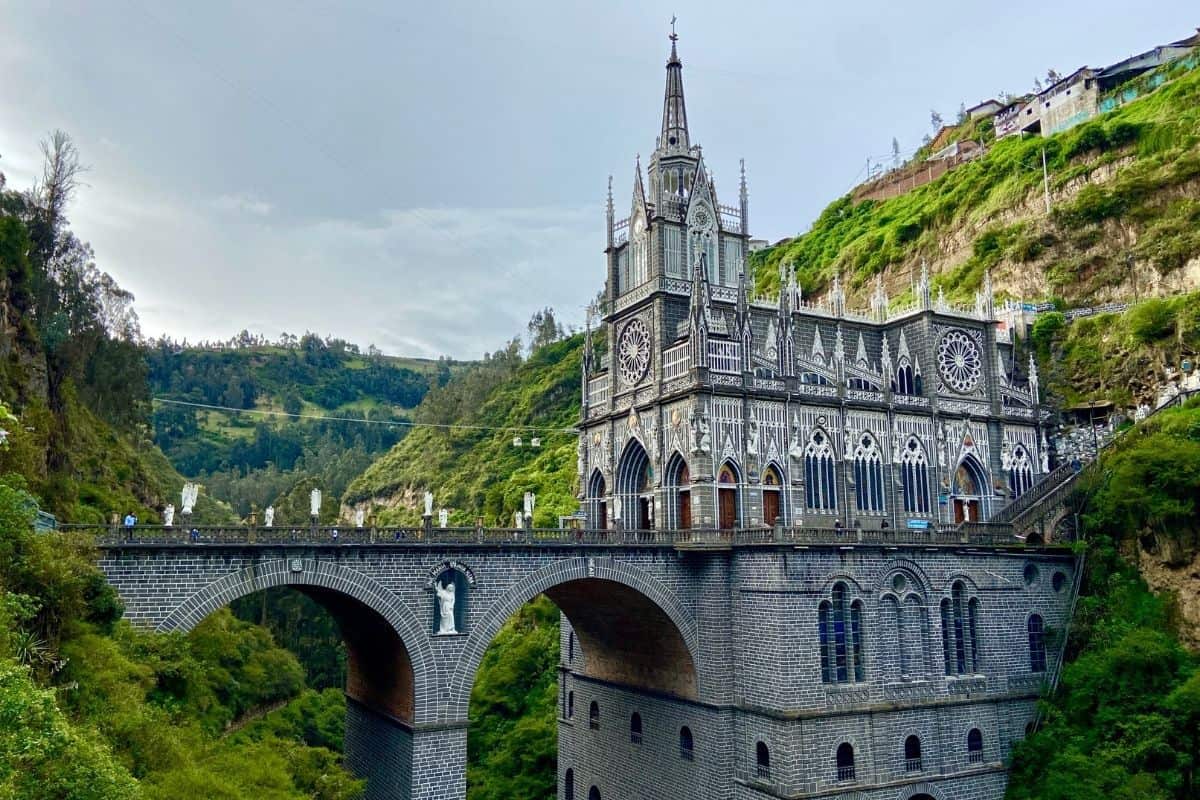The Las Lajas Sanctuary Colombia Travel Guide
Intro - Why Should You Visit Las Lajas Sanctuary?
Las Lajas Sanctuary, Colombia—more properly known as the Shrine of Our Lady of Las Lajas, also known as Las Lajas Shrine and (inaccurately) the Cathedral of Las Lajas—is one of the most famous churches, if not the most famous church in Colombia, and it’s certainly unique in all of the world.
Why is Las Lajas Sanctuary famous?
This Catholic church, a basilica built in a Gothic style of architecture, is famous for two main reasons. Firstly, for being among the most beautiful churches in the world. Secondly, for being what Catholics consider the site of an apparition of the Virgin Mary.
Why is Las Lajas Sanctuary unique?
What makes Las Lajas Sanctuary unique is not only its architectural style, but its topography. This gorgeous church in the Colombian Andes mountains was built into the wall of a steep canyon. Flowing down below is the Guáitara river, into which falls a beautiful cascading waterfall.
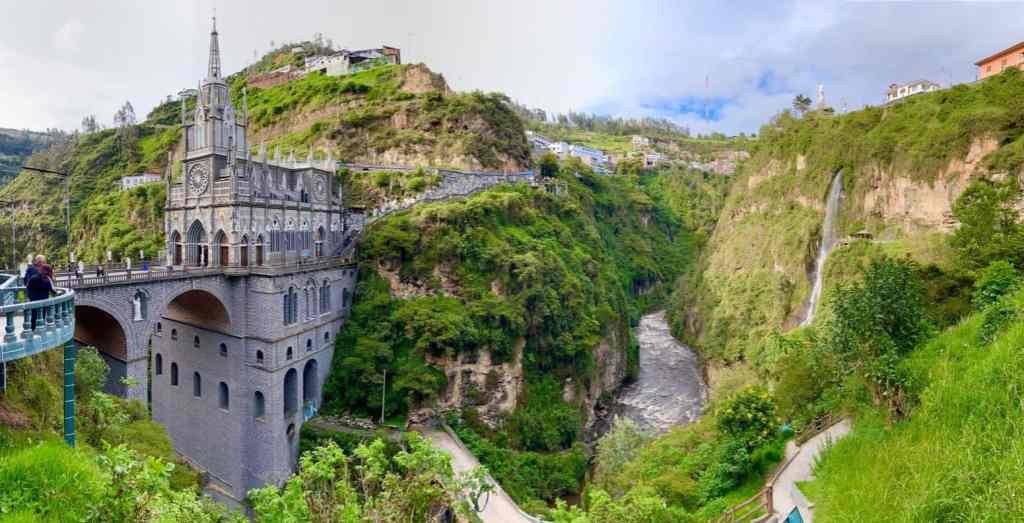
As a result, it resembles a real-life Rivendell from Lord of the Rings. If that isn’t enough for you to geek out on, how about The Legend of Zelda? Spanning the canyon is an impressive stone bridge that calls to mind a shortened version of the Bridge of Hylia.
So, why visit Las Lajas Sanctuary, Colombia?
Maybe because you want to see a site that looks like it came from a Tolkien novel. (Or from the pixels of a Zelda game.)
Maybe you’re a devoted Catholic who wants to visit a famous pilgrimage site, and an extraordinarily beautiful one at that.
Or maybe it’s just that you’re a sucker for architectural marvels and/or visiting totally unique places in the world.
Whichever applies to you, you’ll definitely want to add Las Lajas Sanctuary Colombia to your bucket list of must-see sites. And that’s why we’ve created this travel guide to one of the most beautiful and unique places you’ll ever see!
In this article, we’ll discuss the history and legends surrounding this site. We’ll talk about how to get there and how to make the most of your visit. We’ll discuss what else you can do in the area, hotels to stay in, and whether the area is safe. (Spoiler: it is.)
Even better, we’ll let you take a 360-degree virtual tour!
Table of Contents
✧Las Lajas Sanctuary History
✧Our Lady of Las Lajas Debunked?
✧Who Built Las Lajas Sanctuary, Colombia?
✧Las Lajas Sanctuary Architecture
✦VIRTUAL 360-DEGREE TOUR OF LAS LAJAS SANCTUARY COLOMBIA✦
✧What’s the Best Time to Visit Las Lajas Sanctuary?
✧Where is Las Lajas Sanctuary Located?
✧How to Get to Las Lajas Sanctuary, Colombia
✧Making the Most of Your Visit to Las Lajas Sanctuary
✧Other Things to Do Near Las Lajas Sanctuary
✧Where to Stay in Ipiales
✧Is It Necessary to Stay Overnight in Ipiales?
✧Is Ipiales Safe?
✧Conclusion - Visiting Las Lajas Sanctuary, Colombia
Las Lajas Sanctuary History
The Story of Our Lady of Las Lajas - How It All Began
(Note: as with many legends, there are often many differing versions of the story. In the following sections, I’ve shared the most commonly cited details of this legend.)
The legend goes back to the mid-18th century and involves an indigenous woman named María Mueses de Quiñónez. Popularly known as “La Juana,” she was a descendant of the chiefs of the nearby town of Potosí.
One day in 1754, María was walking alone along the the river canyon when a violent storm caught her by surprise. She took refuge in a cave near the riverbank. Frightened by tales of the devil appearing in that area, she prayed to the Virgin of the Rosary for help.
At that moment, says the legend, she felt someone touch her on the back. Fearfully, she turned around and saw nothing, but her fright was so overwhelming that she rushed out of the cave.
The First Miracle and Apparitions
Some days later, María returned to the site from the nearby town of Ipiales. On her back, she carried her young daughter Rosa, who was born deaf and mute.
When she arrived at the cave, she sat down to rest. After some time, Rosa shocked her as she spoke for the very first time in her young life. “Mommy, look at that mestiza who’s fallen down with her child in her arms and two other mestizos by her side.”
But María didn’t see anything.
After leaving the cave, María and her daughter Rosa walked to Ipiales. There, María told some of the townspeople about what had just happened. They didn’t believe her, so she began to walk back to her house in Potosí.
Along the way, she passed near the same cave, where Rosa once again spoke. This time she shouted, “Mommy, the mestiza is calling me!” but the still-shocked María continued with her daughter back to Potosí.
Once at the house, María was reflecting on everything that had happened, when she realized that Rosa had disappeared. Anxiously searching for her, something told María to go back to the cave. It was there that she found Rosa, but she wasn’t alone.
The legend goes on to say that Rosa was on her knees at the feet of the mestiza, the Virgin Mary, and she was playing happily with the mestiza‘s young son, the child Christ.
The Second Miracle
As you might expect, this supernatural encounter went unnoticed because nobody believed María when she told them about it. However, that all changed after the occurrence of a miraculous event, around which this legend is based.
One day, María’s daughter Rosa tragically died. A distraught María carried her lifeless body to the Virgin Mary in the cave, pleading for her to resuscitate her daughter. So strong was her faith that the mestiza answered her prayers and revived Rosa (or so the story goes).
This time, the people of Ipiales had no choice but to believe María, and they organized a great pilgrimage to the cave outside of town on September 16th, 1754.
Upon arrival, they were overjoyed to see the image of the Virgin of Las Lajas painted on the stone, with the child Christ in her arms and Saint Francis and Saint Dominic at her side. It was the same image which we can see today.
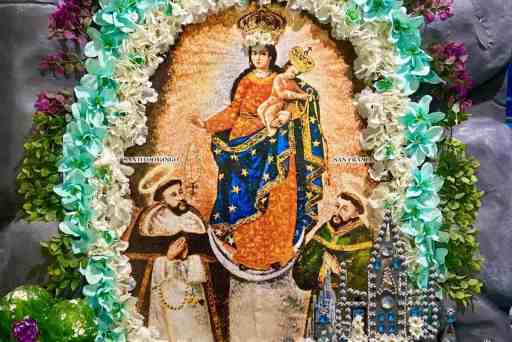
Since that time, the locals have attributed healing properties to the water in the canyon around the church, and there have been reports of sick people being miraculously healed. The church has become a famous and sacred site for Catholics who make pilgrimages there, visiting from just about every country.
Sources (in Spanish):
laslajas.org
santuariolavirgendelaslajas.com
Our Lady of Las Lajas Debunked?
In this section, I’ll be focusing purely on the claim that could theoretically be proven or disproven: the famous image on the rock wall.
As for the apparition of Our Lady of Las Lajas, much like some other well-known claims of Marian apparitions such as Our Lady of Guadalupe and Our Lady of Lourdes, it happened so long ago that it would be impossible to prove or disprove. You can’t exactly dust the scene for fingerprints.
The same is true of the claims of miraculous healings in the waters. A few were alleged to happen in the somewhat distant past. If there have been more recent claims, they’re usually a lot of hearsay.
In fact, no evidence exists that has proven claims of faith healings or other “medical miracles” at Las Lajas or elsewhere.
But I’m not here to dissuade anyone from belief in the above phenomena. If you have faith in Marian apparitions and miraculous healing, far be it from me to argue with you.
The Myth of the Our Lady of Las Lajas Image
What I do want to discuss is the famous Our Lady of Las Lajas image on the rock wall that the whole shrine is dedicated to. There are numerous writings in books and on websites about Las Lajas that repeat the same unsubstantiated grandiose claims about it.
They say that it was not painted on the rock, but rather spontaneously appeared there. Not only that, but they say it was formed by the natural coloration of the rock and even extends several feet into the rock itself.
If such a claim were true, it would be easy to verify. Geologists could drill into the surface of the rock and take samples.
Well, say these sources, they’ve done that already! The Las Lajas image continues to baffle scientists! It’s clear that this is no painting.
The Burden of Proof
Here’s the problem with that: there’s no record of any scientific studies having been done on the rock.
These websites merely repeat the same claims, including that German scientists have studied it or that multiple scientists from twelve different countries have all tried, and failed, to debunk the image.
Of course, not a single source that I’ve found has cited a specific study nor indeed the name of even one scientist who has supposedly conducted one. If so many studies have been done, I would expect to find at least one published in a peer-reviewed journal. But I’ve found nothing.
Furthermore, there is no apparent evidence on or around the image that would indicate that studies have been carried out. There are no holes in the rock. How on Earth would somebody verify the claim that the image extends several feet into the rock without drilling into it?
And finally, there’s the curious fact that the image happens to be in the local art style of the time, known today as Spanish Colonial art (thanks to reddit user Anonymous-USA for informing me of that). If you compare it to images of Spanish Colonial art, it looks strikingly similar.
Even the official documentary which plays in the museum beneath the sanctuary points out that the painting looks a lot like 18th-century art from Quito, Ecuador.
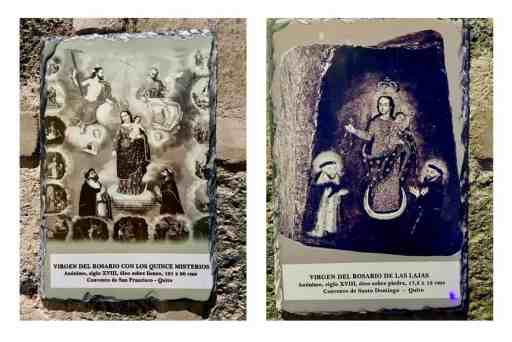
I’ll let you form your own opinion, though personally, my money’s on “painting, not miracle.” Even if that’s the case, it doesn’t completely rob us of the fun of mystery and intrigue. There would still be the question of who was responsible for the artwork.
No one knows the answer to that question, but we do know the answer to a related one:
Who Built Las Lajas Sanctuary, Colombia?
The construction of Las Lajas Sanctuary Colombia was the combined effort of many different people, both Colombian and Ecuadorian, including inexperienced and untrained townspeople and indigenous people.
Many lost their lives doing the dangerous work high above a rocky river canyon.
The entire project took place over a period of almost two hundred years and can be divided into five different stages. In each stage after the first one, a new building was constructed over the previous one.
The First Stage
In 1754, Friar Gabriel Villafuerte constructed a shrine to house the newly discovered image. It was a small hut of wood and straw.
The Second Stage
In 1769, Fray Luis Herrero granted permission to blind Ipiales resident Manuel “El Ciego” Rivera to go from town to town in Colombia and Ecuador collecting donations to buy materials for the construction of a new chapel to replace the old shrine.
On January 1st, 1795, quarry workers began preparing the stones which would be used to construct the chapel. Construction went on in full force, overseen by the Ecuadorian priest Eusebio Mejía y Navarro, at the beginning of 1796.
The process took seven years and resulted in a domed structure of stone and lime, measuring 7 meters long by 6 meters wide (approximately 23 feet by 20 feet).
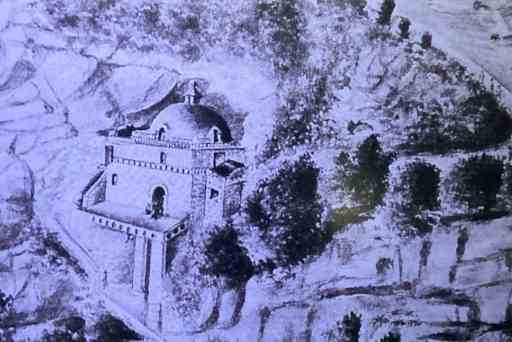
(Note: some sources, even a monument at Las Lajas Sanctuary, incorrectly cite the starting date of construction as 1765 or 1769. However, documents of the life of Eusebio Mejía y Navarro prove that impossible, as he would have been a child at that time.)
The Third Stage
The previous building proved too small to accommodate the masses of pilgrims who frequented the site.
So throughout the second half of the 1800s, Father José María Burbano y Lara undertook the widening of the building, with direction from the Ecuadorian architects Mariano Aulestia and Simón Atapuma.
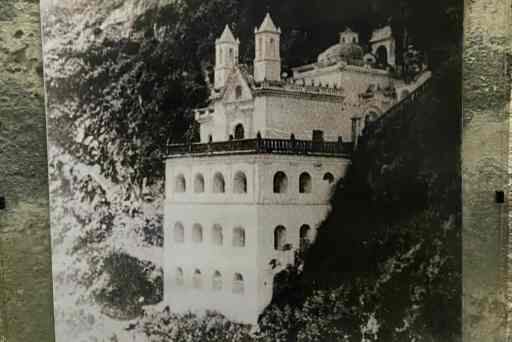
Additionally, a priest named Henry Collins ordered the drilling of a tunnel into the canyon wall in order to create the beautiful, artificial waterfall that is part of the allure of the site today.
The Fourth Stage
The next step was to connect the church to the opposite side of the canyon via a bridge that would also serve as a plaza as well as the church’s atrium. This idea gave birth to the fifth and final stage:
The Fifth Stage
This was the construction of the current sanctuary building. The idea to construct this new temple belonged to Ezequiel Moreno Díaz, the bishop of Pasto, Colombia, who wanted a larger, more modern building that could accommodate the increasing number of visiting pilgrims.
On September 15th, 1899, the first stone of the projected temple was laid and blessed. However, the plans failed due to the lack of expertise of the construction workers at the time.
Later, Bishop Moreno’s successor, a Spaniard by the name of Leonidas Medina Lozano, hired the Ecuadorian architect Gualberto Pérez to design the bridge and the new temple, and on January 1st, 1916, the “first second” stone was laid and blessed.
The project was undertaken by Gualberto Pérez along with the architects Lucindo Espinosa and Julián Espinosa González, as well as the chaplains José María Cabrera, Angel María Chamorro, Juan Bautista Pérez, and Alfonso Romo.
The plan suffered yet another setback as the first attempted construction of the bridge collapsed and fell into the canyon. This loss of materials and money stopped the project for several years.
Eventually, construction continued, and the project was finally completed on August 20th, 1949, under the direction of Justino Castulo Mejía y Mejía—a beautiful neo-Gothic structure with jagged spires and huge stained glass windows that absolutely must be seen in person.
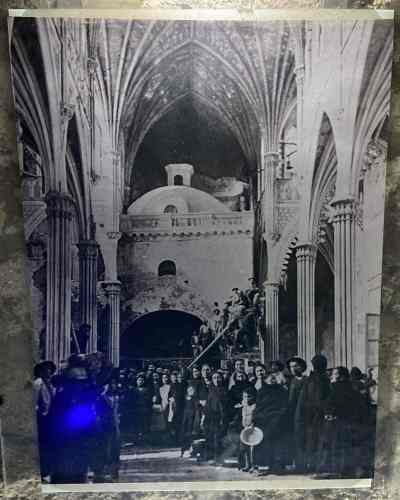
Sources:
laslajas.org (in Spanish)
El Santuario de la Virgen de Las Lajas - Pagina Oficial (in Spanish)
Wikipedia (in Spanish)
Wikipedia (in English)
Colombian Ministry of Culture (in Spanish)
Comprar en Ipiales (in Spanish)
Las Lajas Sanctuary Architecture
The current building is a gray and white stone basilica church (not a cathedral, as it is often erroneously called). It was constructed between 1916 and 1949 in a Gothic Revival, or neo-Gothic, style, imitating the 14th-century Gothic.
The basic design of the building is the traditional basilica form, a rectangular hall composed of three naves (vaulted ceilings shaped like an inverted ship). The central nave is taller than the lateral ones.
The building is constructed atop a bridge of two foundational arches that crosses the river. It functions as the church’s atrium or square in addition to joining the church to the other side of the canyon. It’s made of gray stone and bricks and is flanked by statues of angels playing musical instruments.
The height of the church, from its base at the bottom of the canyon to the top of its tallest tower, is 100 meters (330 feet). The bridge is 50 meters high, 17 meters wide, and 20 meters long (165′ by 56′ by 66′).
The main temple building is 27.5 meters long by 15 meters wide (90′ by 49′). It has three main towers (the tallest of which is a clock tower), numerous spires, pinnacles, buttresses, open arches, and stained glass rose windows.
Las Lajas Sanctuary Interior
The interior of the temple is white with gold trim. The ornate ceilings of the naves are ribbed vaults. Beautiful stained glass windows and rose windows, designed by prolific German artist Walter Wolf Wasserhouen, cast an otherworldly light inside the sanctuary.
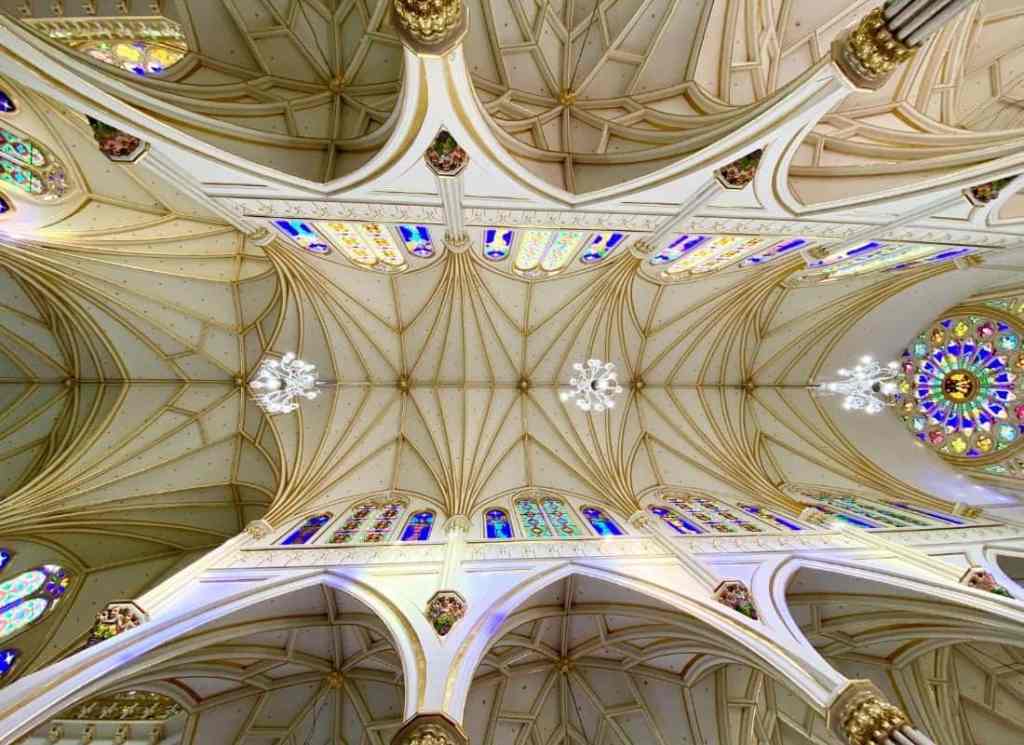
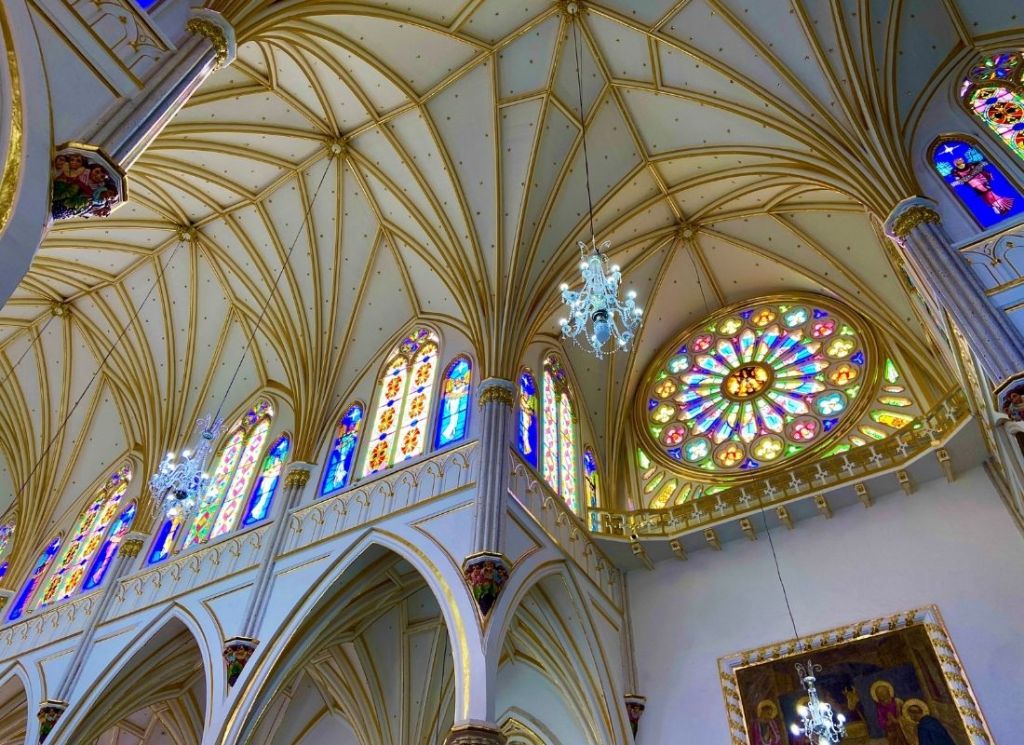
Opposite the front entrance, the rear wall behind the altar is the natural rock wall of the canyon itself. The centerpiece of that wall is the mysterious painting which the church was constructed to house.
Beneath the floor is the base of the temple. It, along with the arches of the bridge, is a crypt imitating the Romanesque style. It’s composed of three barrel-vaulted naves.
A “Shocking” Benefit
As mentioned, the foundations of both the sanctuary and the bridge are a great number of arches. Although that was a purely aesthetic decision, it had an unexpected benefit: it made the church earthquake proof.
With several volcanoes circling it, the area of Las Lajas is a hotbed of seismic activity. Yet the church has remained completely intact, despite the numerous earthquakes that have occurred there.
The reason, according to the church museum’s documentary, is that the arches disperse the seismic shockwaves. This prevents them from causing too much stress to the construction.
Virtual 360-Degree Tour of Las Lajas Sanctuary, Colombia
If you want to get a taste of this majestic site, there are two virtual tours you can take. Here is the first one, which allows you to explore the bridge and the Las Lajas Sanctuary interior:
The other tour is perhaps a little less user friendly, and doesn’t include the interior of the temple, but it does let you explore more of the grounds around the sanctuary.
For best results, be sure to check out both. Neither one can replace the experience of actually visiting Las Lajas Sanctuary, Colombia, though. So let’s talk about how you can visit the real thing!
What’s the Best Time to Visit Las Lajas Sanctuary?
To answer this question, it’s easier to tell you when not to visit. The busiest times of the year are on January 15th and 16th, when there are anniversary celebrations, as well as Holy Week (Easter week).
During those times, huge crowds descend on the site, and it becomes next to impossible to enjoy yourself. It’s best to visit outside of those holidays, especially on a weekday, if you can.
Also keep in mind that Colombia’s rainiest months are April to May, and again from October to November. If you visit during those months, bring your rain gear with you, just in case.
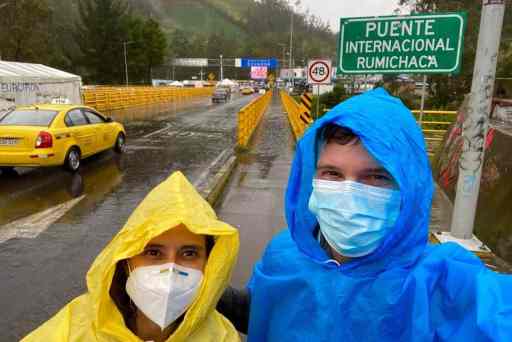
Now that you know when to visit, let’s look at where it is.
Where is Las Lajas Sanctuary Located?
Las Lajas Sanctuary Colombia is located within the municipality of Ipiales, in the department of Nariño. It’s roughly 7 kilometers (4 miles) southeast of the Ipiales city center (20 de Julio Park), and 11 kilometers (7 miles) east of the Rumichaca International Bridge at the Colombia-Ecuador border.
The city of Ipiales sits right next to the border. It’s extremely far from the places most tourists in Colombia tend to go, so it’s more common for travelers in Ecuador to hop across the border and visit Las Lajas Sanctuary than it is for tourists in Colombia.
However, even for travelers in Colombia, it can be easy and uncomplicated to plan a trip there. So let’s discuss getting there from both countries.
How to Get to Las Lajas Sanctuary, Colombia
From Ecuador
The cities in Ecuador you’re most likely to make the visit from are Quito or Otavalo. From either city, you’ll be catching a bus to the border town of Tulcán.
Getting to Tulcán.
From Quito’s Quitumbe bus terminal in the south, it’s about a 6-hour trip and costs $8 USD. From the Carcelén terminal in the north, it takes about 5 hours and costs $7. (Prices quoted are for the bus company Expreso Tulcán.)
If for whatever reason you can’t find a direct bus to Tulcán, you can take a bus to Otavalo (~2.5 hours) and then transfer to Tulcán. From Otavalo’s only bus terminal, the trip to Tulcán takes about 3 hours and costs $5.
From Tulcán to the Border
After you arrive in Tulcán, you need to get to Rumichaca Bridge at the border. For that, you can either take a taxi (that’s probably best if you’re traveling with a lot of luggage) or a colectivo, which is a shared vehicle. Neither option will cost more than a few dollars.
Your transport will let you out at the Ecuadorian customs office, where you’ll need to get your exit stamp.
Afterwards, you’ll cross the border via the Rumichaca Bridge (a modern add-on to a natural stone bridge that’s been traversed by humans since long before the Incan Empire reached it) and enter the Colombia Immigration office to get your entry stamp.
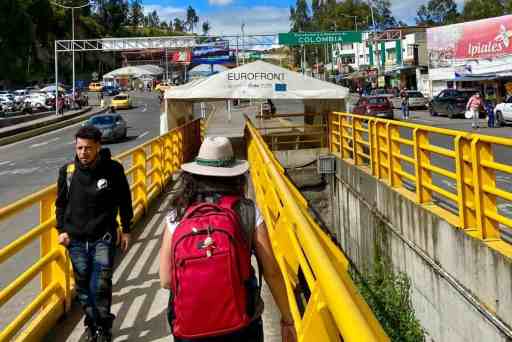
Be sure to stop at the currency exchange office after you pass through Immigration (on the right side of the road). You’ll need to exchange some of your USD for COP (Colombian pesos).
From the Border to Las Lajas Sanctuary, Colombia
Next, you can either take a taxi directly to Las Lajas Sanctuary ($22,000 COP) or to the Ipiales bus station ($10,000 COP).
The second option is really only necessary if you’re staying overnight and/or have luggage with you. You can either check into your hotel or pay for the bag check service at the Ipiales bus station.
From the bus station, you can get to Las Lajas Sanctuary by taxi ($12,000 COP) or colectivo ($3,500 COP). The Sanctuary itself has no entry fee.
From Within Colombia
Getting to Ipiales
If you’re already in Colombia, then make your way to the border city of Ipiales. You can get there by air or by land.
🛩 By Air
Ipiales has a small airport on the outskirts of the city, the San Luis Airport in the town of Aldana. You can fly there and then take a 25-minute taxi ride to the Ipiales bus station for around $20,000 COP.
However, as the airport is so small, it only receives a limited number of flights from Bogotá and Cali. If you’re coming from a different city, you’ll have better luck flying into Pasto. From there you can take a bus to Ipiales (about 2 hours).
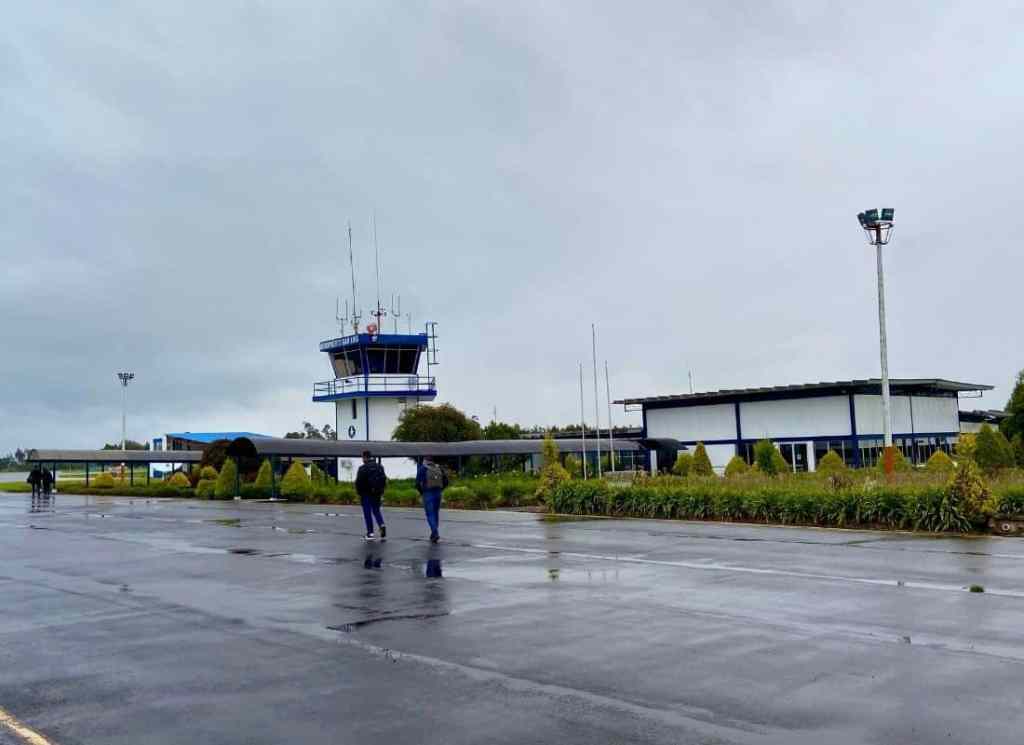

In my opinion, air travel is the way to go. I’ve said it before, but Ipiales is insanely far from the usual tourist destinations in Colombia. A bus trip from Bogotá or Medellín to Ipiales can easily take more than 20 hours (!!!).
Sure, air travel costs more (round-trip flights from Bogotá to Ipiales range between $100 and $200 USD per person). But saving yourself 19 hours or more of your time is well worth it.
Honestly, unless you’re making a leisurely backpacking trip towards Ecuador, stopping in Popayán and Pasto along the way, I don’t recommend taking a bus. But if you’ve already made up your mind…
🚌 By Land
You can find buses to Ipiales from many cities. Pasto, Popayán, Cali, Armenia, Bogotá, and Medellín are just some of them. If you can’t find a bus to Ipiales from wherever you are, then try for Pasto or, failing that, Popayán.
You can then catch a bus that will take you to Ipiales. The trip takes 2 hours from Pasto or 8 hours from Popayán.
From Ipiales to Las Lajas Sanctuary
Once at the Ipiales bus station, your next step is probably to figure out what to do with your luggage.
If you’re itching to see the gorgeous Las Lajas Sanctuary right away, there is a bag check service at the bus station. After checking your bags, you can take a taxi ($12,000 COP) or colectivo ($3,500 COP) directly to Las Lajas Sanctuary, which costs nothing to enter.
Your other option is to take a taxi to your hotel. You can ask the driver to wait for you while you check in and drop off your luggage. That way you can continue on to Las Lajas. Otherwise, head back to the bus station whenever you’re ready, and take a taxi or colectivo to the Sanctuary.
Pro Tip! Get Your Driver’s Phone Number
If you take a taxi, I recommend getting your taxi driver’s phone number. You can contact them when you’re ready to leave and have them pick you up wherever they dropped you off.
If you don’t get their digits, or if you’re traveling by colectivo, just don’t stay too late. It can be hard to find transportation back to town after about 6 or 7pm. But it’s worth staying after dark, for reasons I’ll explain later.
If you want a recommendation for a reliable taxi driver in Ipiales, email me.
Making the Most of Your Visit to Las Lajas Sanctuary
The Drive Down
On the way there, there is a mirador (scenic overlook) from which you can get a breathtaking first view of the sanctuary nestled in the canyon. Most taxi drivers know to stop there (not sure about the colectivos), but you can ask them to stop just in case.
Afterwards, you have two options. You can have your driver drop you off at the teleférico (aerial cable car) or at the entrance to the footpath down to the church.
Option 1. Taking the Teleférico
2015 marked the beginning of a new, relaxing and scenic method of transportation to the sanctuary. This cable car gives passengers an impressive aerial view of the river canyon, which it crosses twice during the 1400-meter, 18-minute journey.
Normally, the teleférico is open from 8 a.m. to 6 p.m. and costs $12,000 COP for adults or $8,000 COP for children and senior citizens. Children under 5 ride for free.
During peak seasons (December, January, and Easter Week), the hours are from 7 a.m. to 8 p.m. and a ticket costs $15,000 for adults, $10,000 for children and seniors. For more information, check out the Teleférico Las Lajas official site (in Spanish).
If you choose this method of transport, you’ll end up behind the sanctuary building. You can skip the next section and continue with the tour.
Option 2. Walking to Las Lajas Sanctuary
If you choose to make the journey on foot, your driver will continue past the teleférico. After a couple of minutes, they’ll let you off at the entrance to the footpath that leads to the church. You’ll see a number of small shops and hotels.
Here you’ll begin a 10- or 15-minute trek downhill towards the church. Note that there are also numerous stairs involved. It’s not wheelchair-friendly.
Along the way, you’ll see many stores selling souvenirs and religious items. You’ll also see walls covered in plaques with words of gratitude and devotion to the Virgin Mary.
As you get nearer to the Las Lajas Sanctuary, you’ll eventually come to a statue dedicated to Manuel “El Ciego” Rivera. He’s the previously mentioned blind man who walked around Colombia and Ecuador raising funds for the construction of the second phase of the sanctuary.
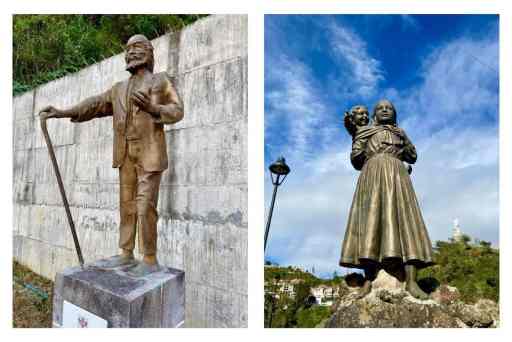
A little farther down the path, you’ll find an overlook with a view of the canyon and the artificial waterfall. After that, you’ll come to a statue of María Mueses de Quiñónez and her daughter Rosa, the protagonists of the Las Lajas legend.
Just beyond here, you’ll come up behind the church. You’ll see the top of the building with its impressive towers and spires. To the right, you’ll see the other entrance of the teleférico. This is also where you’ll be let off if you chose to ride the cable car down instead of walking.
Arriving at the Church
On the side of the sanctuary opposite the teleférico station, you’ll head down two flights of stairs to get to the church-floor level. Again, it’s not wheelchair-friendly!
At the bottom of the stairs, you’ll see on your left the entrance to another stairway that will take you down to the crypt and the museum. We’ll come back to these in a minute.
Continuing past the museum entrance, you’ll come to the corner of the church. Here your path will open onto the stone bridge. You might want to walk to the far end of it, where you can take a great photo of the front of the sanctuary.
You can also get some great shots of the angel statues that line the bridge, the surrounding canyon, and the waterfall. You might want to experiment with some panoramic shots of the area.
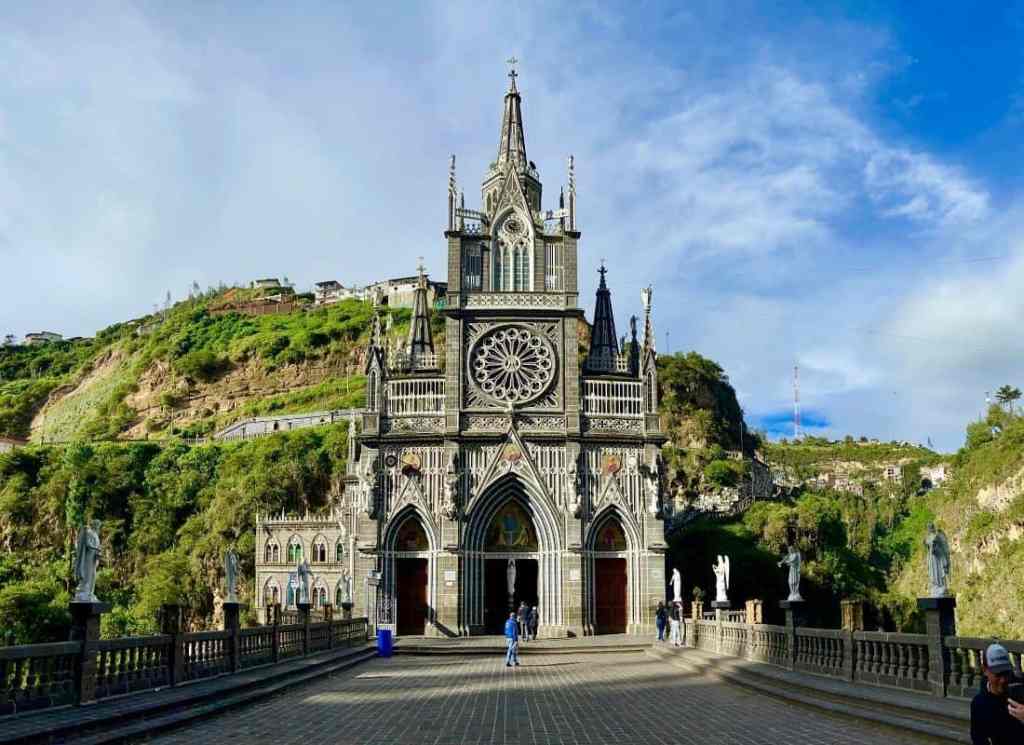

Entering the Sanctuary
Probably the next thing you’ll want to do is visit the Las Lajas Sanctuary interior. When you walk in, you’ll notice the beautiful natural lighting coming in from the stained-glass windows that span the length of the church.
Be sure to get a photo of the exquisite gold-trimmed vaulted ceilings before making your way to the back of the church. There, you can get a photo of the famed image of Our Lady of Las Lajas, painted on the canyon rock which forms the rear wall of the building.
The image is encased in glass, and you can’t get very close to it. There’s a barrier between you and the altar. Still, you can get a nice photo of the wall with the image on it.
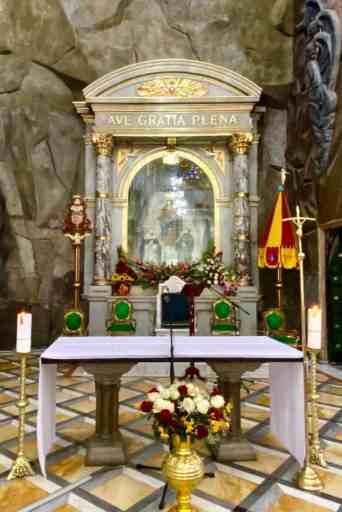
The Basement
Exiting the sanctuary, you might now want to explore the basement. Go back around the corner to your left and head down the stairs. Right away, you’ll start appreciating the arches and the barrel-vaulted ceilings.
At the foot of the stairs, to your left is the crypt, built by Antonio Pueyo de Vall. It’s called the Temple of the Sacred Heart of Jesus, and its pillars and vaulted ceilings are illuminated with lighting that changes colors frequently.


To the right of the foot of the stairs is the museum. It costs $3,000 COP to enter. (They’ll accept $1 USD, but at the time of writing this article, that’s more expensive than if you pay in pesos.)
The museum is worth the entry fee. There’s a 15-minute documentary about the history of the site. There are photos of the old temple buildings and relics from the church’s past.
There’s even a wing dedicated to the art and lifestyles of the pre-Columbian societies of the surrounding area of Nariño, Colombia. You’ll definitely want to take your time learning about the history of this beautiful place!
Exploring the Grounds
Back on the ground floor, if you return to the far side of the bridge, you’ll see a path on the lefthand side. This path will take you to an area with some restrooms, gift shops, and a restaurant.
I don’t recommend eating there.
In our experience, the food was served cold. That was probably just because it was late when we ate there. But even aside from that, it was bland. I suggest you eat elsewhere before or after your visit.
But more importantly, from the restaurant area, there are numerous paths that branch upwards, downwards, and on both sides of the church. You should take your time exploring these different avenues.
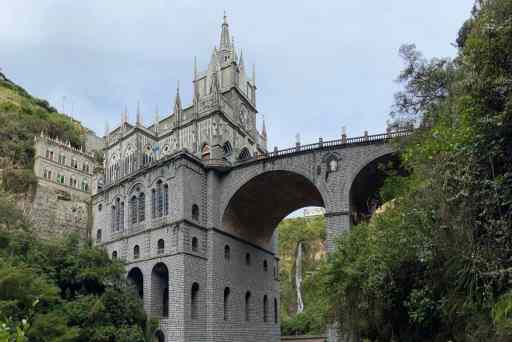
You’ll find many different angles to photograph the church from. There are even professional photographers all over the place who know the best spots to snap your picture with the church behind you.
Roaming around, you’ll also find your way up to the waterfall. It may be artificial, but it’s positively breathtaking.
Las Lajas Sanctuary Colombia - After Dark
I strongly recommend you take your time exploring the church and the grounds. That way, you can stick around till nightfall, when the church is completely transformed.

Around 6 or 6:30 p.m., the entire sanctuary is lit up with a multicolor light show. Vivid reds, greens, blues, purples, and yellows bathe the church in their glow.
The lights twinkle and dance, sometimes slowly changing colors, and other times quickly jumping from one to the next, as if in sync with the beat of unheard music.
It’s a spectacle so worth viewing that I would actually suggest you plan your visit for the late afternoon. That way, by the time you’ve explored the church grounds, it’ll be nearly nightfall.
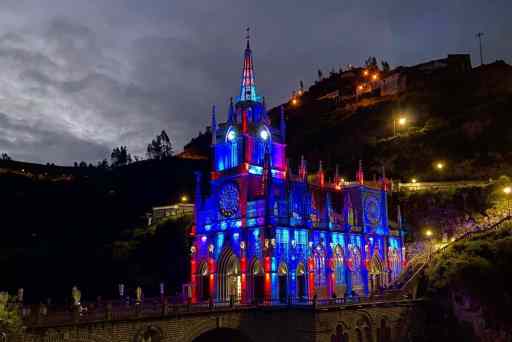
Leaving Las Lajas
Once you’ve had your fill of the natural and architectural beauty, it’s time to exit. If you’ve stayed past sundown, you should call your taxi driver before you begin the hike out of the canyon and tell them to meet you where they dropped you off. The walk back is still safe after dark, don’t worry.
If you’re leaving earlier in the day, you can either walk the path back to the entrance, or take the teleférico out of the canyon.
From the footpath entrance or the cable-car station to the main road, you should be able to find taxis and colectivos back to the Ipiales bus station or to your hotel. Ask somebody if you’re not sure where to go to catch your transport.
Other Things to Do Near Las Lajas Sanctuary
Apart from the sanctuary itself, which draws thousands of tourists from many different countries each year, Ipiales isn’t a touristic city. Even some locals say there’s nothing to do there apart from visiting the church.
Nevertheless, there are some activities you can enjoy in the area.
Shopping
Ipiales is a popular shopping destination for Ecuadorians. They cross the border on weekends to save money on groceries, clothes, and electronics, among other items.
Around the 20 de Julio park and San Felipe park, there are numerous stores and wandering vendors selling all kinds of wares. For a calmer experience, there’s also the Gran Plaza, a modern indoor shopping mall.
Visit the El Charco District for Traditional Food
About halfway between downtown Ipiales and Las Lajas, you’ll find the El Charco district. The buildings are all painted with traditional indigenous symbols and motifs. It’s quite charming.
This is also the best place to try the most traditional dish of Ipiales: cuy asado (roasted guinea pig). If you’re an adventurous eater, be sure to stop into one of the many restaurants in El Charco that are famous for serving cuy.
I recommend stopping here on your way to Las Lajas and filling your belly. That way you won’t have to eat at the restaurant on the sanctuary grounds.

See the Exquisite Topiaries of the Tulcán Cemetery (Ecuador)
About as close to the border as Ipiales is, but on the Ecuadorian side, is the city of Tulcán. While there’s not much to do there, there is one place that’s worth a visit: the José Maria Azael Franco Cemetery.
This unique cemetery is known for its abundance of topiary art. In 1936, cemetery caretaker José Maria Azael Franco decided to begin shaping the tall cypress trees into various figures.


Today, these figures are of Greek, Roman, Egyptian, Incan, Arabic, and Ecuadorian styles, as well as animal forms. Azael Franco passed away and was buried among his works in 1985, but his tradition lives on. The topiaries are pruned and maintained every three months.
It’s kind of hard to be in a somber mood walking among these often joyful figures. As some of the visitors said when I was there, it almost makes it worth dying to be buried in a place like that.


Given how close to the border the cemetery is, and that you can see all of it in 30 or 45 minutes, it’s an easy trip to make from Ipiales that’s worth the minimal effort it requires.
To get there, cross the border at the Rumichaca Bridge, then take a taxi from the Ecuadorian immigration office to the cemetery. It’ll cost you just a few dollars each way.
Where to Stay in Ipiales
There are numerous hotels of different levels of quality and price in the area. For a more budget option, you could stay at Hotel Avanty. If you want a more upscale accommodation, you could stay at the Loft Hotel.
Both hotels include breakfast and are located near to both the Ipiales city center and Las Lajas Sanctuary.
Is It Necessary to Stay Overnight in Ipiales?
Not necessarily. It depends on what your plans are and what method of transport you’re using.
You can feasibly visit both the Las Lajas Sanctuary Colombia and the Tulcán Cemetery in Ecuador in the same day. Afterwards, you can travel to your next destination, whether it be Otavalo (Ecuador) or Pasto (Colombia).
However, there are some things to keep in mind.
If you’re going to Ecuador, you can find buses to Quito or Otavalo from the Tulcán bus terminal until probably around 10 p.m.
Plan accordingly. You’ll want to give yourself enough time to pass through immigration and then take a 15-minute taxi ride to the Tulcán bus terminal.
If you’re going to continue on to another Colombian city, be aware of what time you’re leaving. A two-hour night bus to Pasto is probably fine. However, you might want to avoid longer trips, say to Popayán or Cali, overnight. Those routes can be more dangerous at night.
If you’re visiting the sanctuary in the morning and then heading to another Colombian city, you should be okay. But if you want to spend the better part of your day exploring Ipiales and Las Lajas at an easy pace, you’re better off spending the night there.
Especially if you want to see the church at night, which I highly recommend you do.
Is Ipiales Safe?
Short answer: yes. Ipiales is a very safe city. You can walk around the city center without a care in the world, by day. By night, on the other hand, I wouldn’t recommend it.
The only exception is Las Lajas. As I mentioned before, you can stay at the sanctuary till nightfall and walk back to catch your transport. It’s totally safe.
No matter where you are, though, there are always tips you can follow to stay safe in Colombia.
Conclusion - Visiting Las Lajas Sanctuary, Colombia
So, is Las Lajas Sanctuary worth the visit? Hopefully after reading this article, your answer is a resounding YES!
With a rich history, gorgeous natural surroundings, and beautiful neo-Gothic architecture, it’s plain to see why this church is a must-see site. As far as I’m concerned, this real-life Rivendell needs to be on your bucket list.
So what are you waiting for?
📸 For more photos from our visit to Las Lajas and other sites in Colombia (and beyond), follow us on Instagram.

